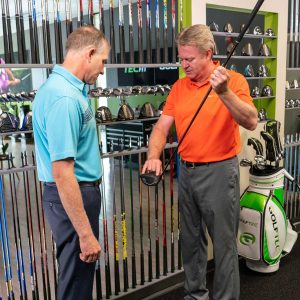Seen on Golf Channel: Adjustable drivers can be a game changer – but only if the settings are dialed in for YOU
 The ever-evolving landscape of golf club design has given us everything from easy-to-hit irons, rough-cutting hybrids, wedges of every grind imaginable and, maybe most notable, adjustable drivers.
The ever-evolving landscape of golf club design has given us everything from easy-to-hit irons, rough-cutting hybrids, wedges of every grind imaginable and, maybe most notable, adjustable drivers.
With the ability to switch out shafts and alter weighting, loft and lie configurations with the simple twist of a screw, adjustable drivers have changed the game of golf forever. But, while the on-the-fly convenience of adjustable drivers can help every golfer hit better tee shots, many don’t implement the correct settings to reap their full benefits.
Weight, I can change that?
 Undoubtedly, altering anything on your driver can be confusing if you don’t know where to start.
Undoubtedly, altering anything on your driver can be confusing if you don’t know where to start.
When it comes to moveable weights, it helps to first understand how various weighting positions affect ball flight and launch. Every club manufacturer is different in how they implement moveable weights, but the concept is fairly standard across the board.
In the case of the TaylorMade M3 driver pictured above, two weights run along the bottom of the clubhead within moveable tracks. Depending on how the weights are positioned, the draw/fade bias and influence on spin can be altered.
For example, if the weights are positioned in the back of the club and toward the toe, it will move the club’s effective sweet spot (CG) more toward the toe and resist twisting closed at impact to influence a fading ball flight. The opposite holds true if the weights are positioned more toward the heel of the club to promote a draw.
In terms of how moveable weights affect spin, more spin tends to occur if the weights are positioned toward the back of the club and less spin tends to occur if the weights are positioned toward the front of the club.
It’s hard to lie about loft
In addition to moveable weights, pretty much every adjustable driver on the market today offers versatile sleeves at the hosel that can alter the club’s lie, loft and open/closed position of the face.
While these elements alone can have a significant effect on ball flight, there are a multitude of ball flight characteristics that can be achieved when combining these variations with different positions of the weights.
What are your settings?
Phew – that’s a lot of information to take in. Still with us?
While it can seem overwhelming to understand how these settings work in relation to your swing, it doesn’t have to be rocket science to figure it out. Of course, the most foolproof way to determine how to adjust your driver is seeing a GOLFTEC fitter who can help through the aid of a high-end launch monitor.
Aside from having an expert club fitter make sense of your adjustable driver, you can at least get a general sense by knowing your typical shot pattern and hitting 10 shots with all settings in the neutral position.
Launching it too high or low? Adjust the sleeve to change loft.
Does the ball nosedive from its apex quickly (too little spin) or, vice versa, seem to “float” and not roll out much after it lands (too much spin)? Move the weights farther back or forward to adjust spin.
In the video below, Nick Clearwater looks into this topic further and explains how tinkering with an adjustable driver’s settings can affect your tee shots. Take a look and start getting the most from today’s driver technology!
VIDEO: Facts and Misconceptions of Adjustable Drivers
If you’re ready to purchase fitted golf clubs, schedule a TECFIT at a local GOLFTEC today!
Like our content? Subscribe to the GOLFTEC Scramble for the latest on instruction, news, equipment and more!








